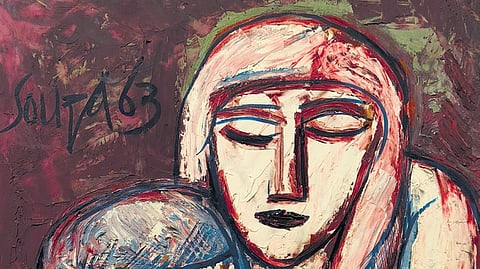The icons of an iconoclast
Renaissance painters painted men and women making them look like angels… I paint for angels, to show them what men and women really look like,” reads a quote by artist Francis Newton Souza on a wall of the Lalit Kala Akademi in Delhi. Souza (1924-2002) was a pioneer of Indian modern art while also being one of its most provocative voices. Throughout his life, his work was characterised by unapologetic experimentation and a uniquely rebellious artistic vision. A founding member of the Progressive Artists Group of Bombay in 1947, he was considered a mentor by figures like MF Husain, with his influence shaping the path that Indian modernist art came to take.
‘Reminiscing Souza, An Iconoclastic Vision’, an ongoing exhibition (till February 15) at the Lalit Kala Akademi, Delhi, celebrates the birth centenary of the artist, with over 160 of his works on display, that span his decades-long and prolific artistic career.
“FN Souza was on the forefront of modernism in Indian art. He brought about a modernist boom for India,” says Yashodhara Dalmia, the curator of the exhibition. Dalmia has had a long association with the works of Souza, with her curating a retrospective on him organised by the Dhoomimal Art Gallery in 2010, which showcased over 200 of his works from the gallery’s private collection. “Souza’s work brings out the underbelly of existence,” says Dalmia, “He was concerned with bringing out all the fragmentation and disturbance of life, as well as the corruption inherent in the powers that be,” she adds.
The exhibition features his early works as well as those made in his twilight years, giving visitors a chance to trace Souza’s evolution as an artist. His depiction of heads and faces, which is, according to Dalmia, one of his strongest features, over the years, serves as a good example. His early sketches are of himself, in a “fairly naturalistic mode”, ‘true to life’ in the conventional sense, while one can see the heads becoming more and more distorted as the years go by. “In painting these ghoulish heads, which had eyes on the forehead,
or gnashing teeth for mouth, or an elongated and “flickering” nose, Souza was formulating a new mode of art and reinventing the human form,” says Dalmia. This personal journey of the artist also offers a window into the journey of modernism in Indian art, she says.
No sentimentality
Born in Portuguese Goa, Souza moved to Bombay (now Mumbai) with his mother while still young. As a student, he was first expelled from Bombay’s St Xavier’s College for making “pornographic” murals on the college’s bathroom walls, and then from the Sir J J School of Art for his involvement in the country’s independence movement. These incidents point towards two of the overarching themes in his body of work – a proclivity towards eroticism and a commitment towards revolting against the rules set by powerful establishments, including those of art and religion. Though a strict rationalist, who was vehemently disdainful towards any form of religion, Souza’s work is populated by Biblical figures and settings, including that of Christ. These paintings hold no “sentimentality” or “reverence”, and are used for the artist’s own personal expression. ‘Pieta’, an acrylic painting from 1963 in which “an overpowering figure of Mary clasps a vulnerable Christ”, hints at the artist’s own complex relationship with the women in his life.
A large portion of the works on display, almost half in number, is nudes. They show both men and women, but especially women, who unabashedly present themselves to the viewer. “Souza was very much influenced by the erotic sculptures at Khajuraho as well as the nude art of the Gupta period. His women are voluptuous, and towards the later years, they are increasingly so. He wanted to present female sexuality in its full freedom and energy and was against its suppression,” says Dalmia. The exhibition also presents his still-life paintings and landscapes.
The influencer
Renowned Marxist art critic John Berger once remarked of Souza: “Souza’s genius straddles many traditions but serves none.” Souza, who lived in and made work at London and New York for a long time, is considered by many not just as a pioneer of modernism in India, but also as a significant figure in the history of modernist art internationally. His work, says Dalmia, had a great influence on those of artists like Jogen Chowdhury and Bhupen Khakhar among others and also paved the way for a generation of young artists. “Souza wanted to lay bare all the hypocrisy of existence, be it in religion, or the art establishment or people. He wanted to present the evil underneath the surface so that one could face it and lead a better life. He uncovered reality and showed it for what it really was,” she says.

